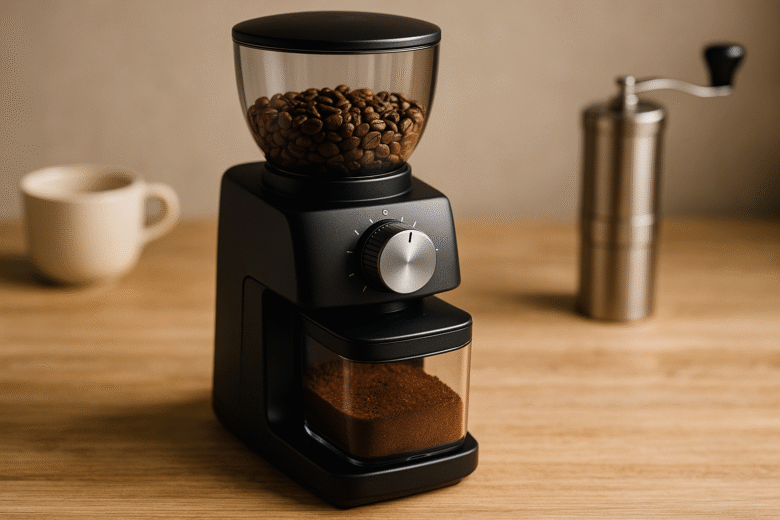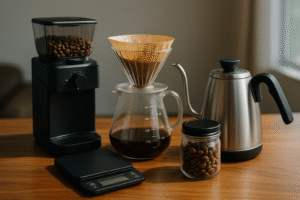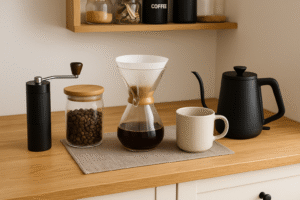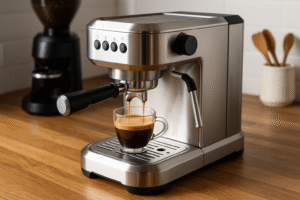A good cup of coffee starts long before water touches the grounds. One of the most overlooked yet crucial elements in brewing is the grinder.
Specifically, the burr grinder. Whether you’re a beginner or looking to improve your setup, understanding how burr grinders work—and why they’re important—can change your coffee experience completely.
Burr grinders don’t just crush beans; they determine grind size, consistency, and ultimately, flavor. If you want to make better coffee at home, investing in a burr grinder is one of the smartest moves you can make.
What Is a Burr Grinder?
A burr grinder uses two abrasive surfaces, called burrs, to crush coffee beans into a uniform size. The burrs can be flat or conical, and the distance between them determines the size of the grind.
This system creates consistent particle sizes, which is essential for balanced extraction.
Unlike blade grinders, which chop beans unevenly and create dust and chunks, burr grinders provide control and precision.
They also minimize heat buildup, preserving the delicate flavors and oils in your coffee beans.
Burr Grinders vs. Blade Grinders
Many entry-level coffee drinkers start with a blade grinder. It’s inexpensive and easy to use—but it’s also highly inconsistent.
Blade grinders use a spinning blade that randomly slices beans. The result is a chaotic mix of fine powder and large pieces.
This inconsistency leads to over-extraction (from the fines) and under-extraction (from the chunks) in the same cup. It causes bitterness, sourness, and muddled flavors.
Burr grinders, on the other hand, crush beans between burrs to produce even particles. This allows for a more even extraction and a cleaner, more flavorful cup.
Why Grind Consistency Matters
In coffee brewing, uniformity equals control. When all your coffee particles are the same size, they extract at the same rate.
This means you can dial in your flavor profile more easily—whether you want sweetness, acidity, or body.
Uneven grounds lead to imbalanced flavors. Some parts of the coffee over-brew while others under-brew.
Consistency allows you to tweak one variable at a time—like brew time or temperature—without wondering if grind size is the culprit.
Types of Burr Grinders
There are two main types of burr grinders: flat burr and conical burr.
Conical burr grinders use a cone-shaped center burr and a ring-shaped outer burr. They’re efficient, quieter, and often found in home grinders.
Flat burr grinders have two flat rings with teeth facing each other. They’re more precise and found in many commercial machines.
Both can produce excellent results, but flat burrs usually cost more and are favored for espresso due to their accuracy.
For most home brewers, a conical burr grinder offers the best balance of performance and value.
Manual vs. Electric Burr Grinders
Manual burr grinders are affordable, compact, and great for travel. They require physical effort but offer excellent control and quality.
Electric burr grinders are faster and more convenient, especially for daily use or brewing for multiple people.
If you’re on a budget or want a quiet option, manual grinders are a great start.
If convenience and speed are priorities, go electric—but choose a model with solid burrs and adjustable settings.
Grind Settings and Brewing Methods
One of the key benefits of burr grinders is adjustability. You can fine-tune grind size for different brewing methods.
- Extra Coarse for cold brew
- Coarse for French press
- Medium-Coarse for Chemex
- Medium for drip coffee
- Medium-Fine for AeroPress
- Fine for espresso
- Extra Fine for Turkish coffee
Being able to switch between settings allows you to explore new techniques and discover what you like best.
Retention and Static
Some burr grinders retain a small amount of ground coffee between uses. This is known as retention, and it can affect consistency and flavor if not cleared regularly.
Static electricity can also cause grounds to cling to the grinder or fly out unpredictably.
Higher-end models are designed to reduce both issues, and simple techniques—like using the “RDT method” (a light mist of water on the beans before grinding)—can help minimize static.
Material Matters: Steel vs. Ceramic Burrs
Steel burrs are sharp, durable, and ideal for most home and professional settings. They offer fast grinding and stay consistent over time.
Ceramic burrs are more brittle but stay sharp longer. They’re often used in manual grinders and are good for low-heat grinding.
Steel is preferred for espresso due to its precision, while ceramic may be better for manual pour-over setups.
Both materials can produce great results—it depends on your budget, brew method, and maintenance routine.
Cleaning and Maintenance
Burr grinders need regular cleaning to prevent buildup of oils and fine particles.
A dirty grinder can affect taste and reduce the lifespan of the burrs.
To clean, disassemble the grinder according to the manufacturer’s guide and use a brush to remove residue. Some brands offer grinder cleaning tablets that can be run through the machine.
Make cleaning a monthly habit if you grind daily, or more often if using oily dark roasts.
Price Range and What to Expect
Burr grinders range from $40 to over $1000 depending on features, build quality, and intended use.
For most home brewers:
- $40–$80: Manual burr grinders, good for pour-over and French press
- $80–$200: Entry-level electric burr grinders with adjustable settings
- $200–$500: Prosumer models suitable for espresso
- $500+: Commercial-grade precision grinders
Choose the best you can afford, focusing on consistency and build quality.
Brands to Consider
Popular brands that offer reliable burr grinders for home use include:
- Baratza (e.g., Encore, Virtuoso+)
- Fellow (e.g., Opus, Ode)
- 1Zpresso (manual grinders)
- Hario (manual grinders)
- Timemore (manual and electric options)
Always read reviews and consider your preferred brew method before purchasing.
Conclusion: A Grinder That Transforms Your Coffee
If you’re serious about better coffee at home, a burr grinder is not optional—it’s essential. It puts you in control, improves flavor, and opens the door to experimentation.
You don’t need the most expensive model, but you do need one that delivers consistency.
Grinding fresh beans with a burr grinder is one of the biggest steps you can take toward café-quality coffee in your own kitchen.

Marcio Luzardo is a coffee enthusiast and the voice behind Tudo Viraliza. With a passion for turning curiosity into practical knowledge, he shares easy-to-follow tips, guides, and insights to help readers enjoy better coffee every day. When he’s not writing, Marcio is exploring new brewing methods or diving into the rich stories that connect coffee to culture, lifestyle, and wellness.



